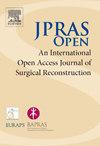干燥纱布与磺胺嘧啶银治疗混合深度儿童烫伤:一项回顾性研究。
IF 1.5
Q3 SURGERY
引用次数: 0
摘要
简介:磺胺嘧啶银1%乳膏历来是我们机构烫伤创面的主要初始治疗。然而,对于所有部分厚度的烧伤,我们转而使用仅由凡士林浸渍的3%三溴苯酸铋纱布(Xeroform)制成的封闭敷料。Xeroform附着在伤口上,同时允许渗出物排出,并充当重新上皮化的支架,之后它会脱落而不会损伤伤口床,理论上允许存活组织自我宣告,而不需要频繁更换敷料。材料与方法:回顾性分析2004年至2008年(以磺胺嘧啶银为标准初始选择)和2015年至2018年(仅以赛罗仿为标准)年龄≤5岁的混合深度烫伤患者的病历。结果:本研究纳入347例患者,其中200例采用磺胺嘧啶银治疗,147例采用单用Xeroform治疗。两组的烧伤面积和植皮率相似(银组30/200 [15.0%],Xeroform组20/147[17.7%])。然而,Xeroform组从损伤到植皮的时间较长(24天比9.9天,p = 0.002),但平均植皮面积明显小于银组(147比336 cm2, p = 0.027)。结论:这些研究结果表明,使用赛罗仿比使用磺胺嘧啶银能更好地促进伤口愈合。此外,在门诊环境中,患有Xeroform的患者可以带着敷料出院进行移植,在此期间,他们使用闭合敷料,没有频繁的更换和相关的不适。本文章由计算机程序翻译,如有差异,请以英文原文为准。
Xeroform gauze versus silver sulfadiazine for mixed-depth pediatric scald injuries: A retrospective study
Introduction
Silver sulfadiazine 1 % cream had historically been the mainstay initial treatment for scald wounds at our institution. However, we transitioned to using closed dressings of only petrolatum-impregnated 3 % bismuth tribromophenate gauze (Xeroform) for all partial-thickness burns. Xeroform adheres to the wound while allowing the exudates to drain and acts as a scaffold for re-epithelialization, after which it falls off without traumatizing the wound bed, theoretically allowing viable tissue to declare itself while requiring less frequent dressing changes.
Materials and Methods
A retrospective chart review was conducted of patients aged ≤5 years with mixed-depth scald injuries between the years 1) 2004 and 2008, during which silver sulfadiazine was the standard initial choice and 2) 2015 and 2018, when only Xeroform was used as the standard.
Results
The study included 347 patients, among whom 200 were treated with silver sulfadiazine and 147 were treated with Xeroform alone. The 2 groups had similar burn sizes and rates of skin grafting (silver group 30/200 [15.0 %] and Xeroform group 20/147 [17.7 %]) However, the Xeroform group showed longer time from injury to grafting (24 vs. 9.9 days, p = 0.002) but showed a significantly smaller mean graft size than the silver group (147 vs. 336 cm2, p = 0.027).
Conclusions
These findings suggest that using Xeroform may promote better wound healing than using silver sulfadiazine. In addition, patients with Xeroform can be discharged with their dressings in place for grafting in the outpatient setting, during which time they are in closed dressings without frequent changes and associated discomfort.
求助全文
通过发布文献求助,成功后即可免费获取论文全文。
去求助
来源期刊

JPRAS Open
Medicine-Surgery
CiteScore
1.60
自引率
0.00%
发文量
89
审稿时长
22 weeks
期刊介绍:
JPRAS Open is an international, open access journal dedicated to publishing case reports, short communications, and full-length articles. JPRAS Open will provide the most current source of information and references in plastic, reconstructive & aesthetic surgery. The Journal is based on the continued need to improve surgical care by providing highlights in general reconstructive surgery; cleft lip, palate and craniofacial surgery; head and neck surgery; skin cancer; breast surgery; hand surgery; lower limb trauma; burns; and aesthetic surgery. The Journal will provide authors with fast publication times.
 求助内容:
求助内容: 应助结果提醒方式:
应助结果提醒方式:


